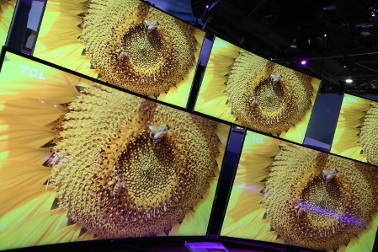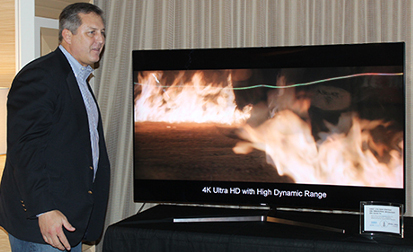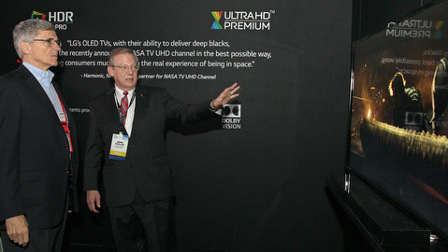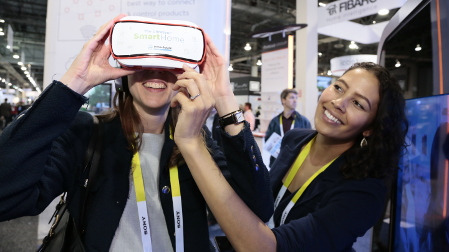HDR, UHD, VR, Mobile Top TV Topics at 2016 CES
LAS VEGAS—As if the alphabet soup of TV technology isn’t confusing enough, CES (no longer called the “Consumer Electronics Show”) dished up an expanding menu of familiar acronyms—HDR, UHD, VR, OTT—as well as new ingredients, including ULED, UAV (aka “drones”), Wi-Fi HaLow and SON, along with LG’s rollable OLED screen. Even the show’s organizer has substituted “Technology" for "Electronics” and is now CTA, the Consumer Technology Association.

Curved TVs on display at CES (Photo courtesy CTA)
CTA’s electronics extravaganza in early January was spiced with pronouncements and demonstrations that ATSC 3.0 is nearly ready for the market plus exhibits and speeches that often generated contradictory outlooks about what mobile TV will become and how the upcoming broadcast spectrum incentive auctions will reshape the industries involved. FCC Chairman Tom Wheeler promised that the upcoming spectrum auction will be “transformational,” and a “huge opportunity” for broadcasters, although he offered few details.
CES exhibitors showcased the predictable huge-screen prototypes, such as LG’s 98-inch 8K/High Dynamic Range screen and TablerTV’s 200-inch (16x8-feet) 8K LCD "TTV Wall." There were drones galore and thousands of media executives with almost as many perspectives on how traditional linear TV will fit into the new "ecosystem," a continually popular term bandied around CES.
BETTER & SMARTER PIXELS
Merely calling CES “overwhelming” has become an understatement. “Perplexing” may be a better term, although that description has applied for many years. The unceasing avalanche of hardware vendors—and now software and systems providers—who represent expanding categories makes it harder to gauge which technologies will survive, let alone thrive.
For example, in the video category—which now includes online/broadband and mobile delivery as well as broadcasting—the long-anticipated High Dynamic Range video display format was ubiquitous throughout CES, with its message of "better pixels." But the primary high-profile HDR supporters showed two variant approaches. The new Ultra HD Alliance protocol for HDR authorizes slightly different versions for OLED and LCD to qualify for the new “Ultra HD Premium” designation.
Pat Griffis of Dolby Labs, a longtime HDR advocate, said during a panel discussion that the formats are not a barrier. “They are not mutually exclusive,” said Griffis, executive director of technology strategy in Dolby’s Office of the CTO and SMPTE committee chair. “We’re on the same page. HDR 10 and Dolby Vision are complementary.” He emphasized the objective: “to reproduce every color we can see as human beings.”
UHD Alliance spec options for HDR displays allow a combination of either more than 1,000 nits peak brightness and less than 0.05 nits black level, or more than 540 nits peak brightness and less than 0.0005 nits black level. Devices also must display more than 90 percent of P3 colors to meet the requirements for the UHD Alliance logo.
The reigning TV set kingpins—LG Electronics and Samsung—used different HDR versions—and different Las Vegas TV stations—for their live broadcast demonstrations of UHD in their CES exhibit booths and hotel suites. Samsung’s demo came via Sinclair Broadcasting’s KVCW channel 29, while LG used KHMP channel 18, owned and operated by DNV Spectrum Holdings.
Adding to the name game confusion, the UHD Alliance established guidelines for use of the term “Ultra HD Premium.” But LG introduced three levels of sets with the tags “HDR Pro,” “HDR Plus” (for high-end 4K screens with expanded color capabilities and advanced sound and picture-enhancing features)and simply “HDR” for basic sets. LG expects its entire OLED line will be among the industry’s first to be certified as “Ultra HD Premium.” LG also introduced a unique picture-on-glass design using OLED technology to build an ultra-thin screen about one-tenth of an inch thick.
Tim Alessi, LG’s director of new product development for home entertainment, acknowledges the challenge: "We definitely need to do a good job on educating the consumer on what HDR is all about.’’
"Supporting this industry-wide push for HDR are important industry elements like CTA’s own guideline for HDR compatible displays and the UHD Alliance’s new specification for Ultra HD Premium," said LG Vice President John Taylor in a CTA video interview. "In the past we talked about more pixels; this year we’re talking about better pixels, smarter pixels [and]... the addition of HDR and wider color gamuts."

ONE Media CTO Kevin Gage introduces the company’s ATSC 3.0 demo from Wynn's hotel suite
The Samsung/Sinclair demonstration also involved ONE Media, (a Sinclair/Coherent Logix joint investment focused on building a next generation broadcast platform), Pearl TV (a partnership of nine large broadcast groups) and TeamCast, a French-based technology provider. Sinclair CEO David Smith attended some of the briefings for broadcasters and analysts attending CES. (See James O’Neal’s in-depth report on the technology behind the demos
here
).
“We are only just beginning to scratch the surface of new B2B and B2C services that the next-gen broadcast platform will enable," said Kevin Gage, ONE Media’s chief technology officer and executive vice president for development, about the ATSC 3.0 demo, calling it an opportunity "to transform the broadcast landscape.”
Indeed, with countless broadcasting executives walking the Las Vegas hallways and aisles, ATSC 3.0’s rollout was part of many discussions. "We are on target to finalize the entire suite of ATSC 3.0 standards for next-gen TV broadcasting this year," said ATSC President Mark Richer.
“A lot of broadcasters seemed surprised that there were two Las Vegas stations broadcasting UHD-TV including HDR,” said Dave Arland, executive director of the Indiana Broadcasters Association and a long-time electronics marketing/publicity executive. The Samsung/Sinclair hotel demo included a custom-built gateway device—a digital pass-through box that showed how the IP signals of ATSC 3.0 can be retransmitted to devices throughout the house.
The goal of the gateway demonstration was to show that an ATSC 3.0 signal with Wi-Fi retransmission could let broadcasters deliver UHD-TV and other services simultaneously, Arland said. The all-IP technology avoids slow channel changes (an unwanted artifact of the early digital TV days) and enables quick transitions between in-channel features such as the local, sports or business segments of a newscast, he said.
During these real-time presentations to broadcasters, "light bulbs went off in their minds" as they envisioned the things they could do with it, Arland added.
BIG, THIN, LOUD & FULLY LOADED
Among other TV makers entering the HDR arena are Chinese manufacturers such as TCL. It calls its system "QUHD" to convey the "quality" of its technology, which features Dolby Vision’s quantum dots approach. Chinese set maker Hisense is labeling its lower-end 4K TV sets as having "HDR processing,’’ starting at $400 for a 43-inch version. Higher-level models will have enhanced "ultra smart peaking’’ to provide a brighter picture. Hisense also pushed its proprietary ULED (Ultra LED) technology, which it claims is "up to three times brighter than OLED with better dynamic range and perception of black and white."
Other TV makers are jumping on the HDR bandwagon, sometimes to supplement their new lines of smart TVs focused on broadband access.
CES saw the shrinking presence of stalwart TV makers such as Sharp and Panasonic and the continuing rise of Chinese brands. Panasonic is cutting back its TV and entire consumer electronics line of business to focus on enterprise systems. Hisense now owns Sharp.
”We plan on dramatically growing our business with both Hisense and Sharp brands this year,” said Mark Viken, a former Sharp executive who is now vice president of marketing for Hisense USA. “We plan aggressive moves to make our brand more visible to consumers.”
Hisense will flood the market, with dozens of new models, many featuring 720p displays.
On the audio side, Fraunhofer IIS, Technicolor and Qualcomm demonstrated a proposed audio standard developed by the MPEG-H Audio Alliance for use with ATSC 3.0. The companies said the standard is intended to let broadcasters and streaming services deliver next generation audio “at comparably low bit rates and in a cost-effective manner.” The standard is competing with Dolby’s AC-4 as the audio standard for ATSC 3.0.
LG’s rollable 18-inch/1-millimeter-thick OLED display prototype grabbed a lot of attention. LG said it expects to bring the technology to large-screen TV displays in a few years. Lenovo also showed a screen that can be rearranged; in this case an OLED screen for its Yoga ThinkPad laptop computer. The screen can be folded back into itself creating a hybrid laptop/tablet that may compete with Microsoft’s Surface devices.
Lenovo also introduced a $279 video projector accessory that can throw a 60-inch image onto a wall.

LG introduced a new line of OLED displays
LG’s OLED lineup included the new iteration of the company’s webOS 3.0 content management platform, which enables viewers of smart TVs to navigate many features. Samsung’s SmartThings platform offers similar Internet of Things control opportunities. There was considerable speculation about whether such proprietary systems will attract public interest, and indeed whether the TV set (rather than a tablet or smart phone) will be a preferred device for the range of functions.
CONTRADICTORY FORECASTS
TV makers expanded their content alliances, ramping up the trend of recent years to embed streaming video providers such as Netflix, Hulu, YouTube and an upgraded Android TV offering into smart TV sets. LG said its newest smart TV will have more than 50 new Internet streaming channels, including services from Wired, BuzzFeed and Vogue.
The issue became yet another contradictory ingredient as speakers at various CES events and conferences offered their appraisals of the video future. In a keynote describing non-broadcast video, YouTube’s Chief Business officer Robert Kyncl described a bullish outlook.
”I don’t think digital video will grow linearly,” Kyncl said. “It will grow exponentially.”
He predicted that online/wireless viewing will constitute 75 percent of total viewing by 2020.
On the other hand, financial analyst Laura Martin, managing director at Needham & Co., pointed out that one of her media clients had seven billion digital views last year but earned only $7 million for those views.
“There’s no money in digital,” she said, “Unless you have the powerful economic machine of television, you’re losing money today.”
Curiously, NBCUniversal CEO Steve Burke offered a different perspective during his keynote at the “C Space” content and marketing track of conferences.
”We need to start getting better at distributing our product on the Internet, getting better at creating new Internet businesses,” Burke said, as he explained his company’s investments in digital publishers such as BuzzFeed and Vox Media. He said that the biggest challenge facing companies like NBCU is the “increasing impact of the Internet on our businesses.”
”One of the reasons we invested in Vox and BuzzFeed was to learn from them,” Burke said.
Such differing viewpoints were underscored by countless data points throughout the CES conference about preferred viewing options. Many speakers cited data about the growing trend toward watching video—including TV content—on mobile devices. Paywizard CMO Bhavesh Vaghela described a study which found that young U.S. audiences (ages 18-34) are using almost three times as many devices to watch video compared to viewers over the age of 55.
He said that based on audiences’ varied device preferences, providers should “employ sophisticated customer retention tactics that target specific persona profiles—from marketing to billing to personalizing the user experience.”
‘SPECTRUM EXTRAVAGANZA
FCC Chairman Tom Wheeler, in his third annual on-stage sit-down conversation with CTA President Gary Shapiro, called the upcoming broadcasting incentive auction “transformational,” adding, “It’s safe to say that you’ll see a ‘spectrum extravaganza.’”
Describing the range of connected devices he saw during his tour of the CES exhibit hall, Wheeler focused on the services those products will deliver.

FCC Chairman Tom Wheeler and John Taylor in the LG booth
“It’s going to be essential to the kinds of things that are going on,” he said. “This is the marketplace deciding what it is the highest and best use for spectrum and in the process creating opportunities not just for wireless carriers but also for broadcasters.”
”There’s a huge opportunity” for broadcasters, Wheeler said, contending that broadcasters have changed their perceptions about the auction, citing channel- sharing opportunities.
Wheeler insisted that the prices and revenue aspects of the auction are secondary. “I am more interested in the spectrum transferred than in the dollars,” he said with a straight face.
Wheeler’s comments came a week before the deadline for broadcasters to sign up for auction participation. Wheeler said that he had seen considerable interest “from broadcasters, the name brand folks, the networks” and also “great interest in this reverse auction.”
He did not cite companies that had yet expressed interest by that date. He called unlicensed spectrum “the innovation band.”
“We want to make sure that there continues to be opportunity in the innovation band.”
During a discussion of the pending appeals court review of the FCC’s controversial “net neutrality” decision, Wheeler asserted that “the process will be sustained.”
Wheeler also addressed privacy issues, especially those triggered by net neutrality enforcement. Asked about smart TVs that can monitor viewers’ activities, Wheeler said it would be no problem if consumers opted in to such data collection. He cited an exhibit he saw on the show floor of a TV that captured information to be sold to advertisers, which he called a “responsible approach” if viewers approve.
IoT SPECTRUM AND NEW WI-FI VENTURES
Augmenting Wheeler’s enthusiasm for fresh uses of the airwaves, two new Wi-Fi flavors emerged during CES. The Wi-Fi Alliance introduced “HaLow” (pronounced “halo” and designated as IEEE 802.11ah), a low-power, long-range wireless system that operates in the 900 MHz band. With a range nearly twice that of standard Wi-Fi connections, HaLow will be aimed at smart home, connected car and digital health applications. It will be able to operate in “challenging environments where physical and electronic impediments such as walls and other electronics are obstacles,” according to the Wi-Fi Alliance.
Separately, Qualcomm unveiled Wi-Fi SON (Self Organizing Networks), a platform designed to enable customers to integrate and manage devices from multiple manufacturers that use various technologies. Qualcomm CEO Steve Mollenkopf characterized W-iFi SON as "unique" because it is the result of his company’s “many years of experience on the cellular side and applying it to Wi-Fi.”
Both HaLow and SON are envisioned as part of the Internet of Things juggernaut, which was a widespread theme of CES. Most IoT applications rely on wireless connectivity, raising the stakes in the spectrum deal-making ahead.
Elsewhere in CES’ airwaves—or air space—dozens of drones plied the skies. Demonstrations were intended to show that it was safe to fly unmanned aerial vehicles in crowded places. Federal inspectors were on hand to explain the restrictions on drones and actually handle registration of UAVs.
VIRTUALLY REAL
Beyond the new Virtual Reality Marketplace—a cluster of nearly two dozen developers of VR equipment—the opportunities for immersive video permeated CES. At the show, CTA issued results of a study it conducted with the National Association of TV Program Executives that hinted of the myriad content opportunities ahead.
CES 2016 attendees testing a VR headset in the Sands Expo Center (Photo courtesy CTA).

”Virtual reality is the latest platform of immersive entertainment, with massive experimentation in content development,” said Steve Koenig, CTA’s senior director of market research. “The VR ecosystem will continue to advance and expand in 2016.”
The CTA/NATPE study found that beyond gaming—which has been the first widely used VR application—horror programs are likely to be the next genre, with sports events, concerts and other live events to be produced in VR “to create a 360-degree view of the action.” On one of several VR panel discussions, Sony Pictures Chief Technology Officer Spencer Stephens called VR “a rich tool with so many possibilities.” Citing the challenge to the creative community in the multiplatform era, he said, “it’s up to the storyteller to learn to tell compelling stories. We make a movie shown on a really big screen with multichannel audio, and yet it’ll still work on my phone.”To create this new kind of video, several companies debuted consumer cameras, such as GoPro’s new 360-degree video camera for about $500. There were also numerous approaches to TV navigation and program discovery. For example, NAGRA introduced an all-in-one TV experience called“intuiTV,” an interface that provides an intuitive, immersive viewing experience. IntuiTV features gesture and voice commands to simplify navigation and search for content: viewers“swipe-to-tune,”left or right, up or down to access recent channels, viewing history, trending programs and new content. It will be offered to pay TV operators as a managed cloud-based platform that can be used to configure a full line-up of premium content and advanced TV services. OVER-THE-TOP
In addition to Netflix’s announcements that it will go global (at least 130 countries) this year and Dish Networks’ introduction of HopperGo, a flash drive about half the size of an iPhone 6, CES was loaded with products and plans for expanding the over-the-top marketplace. Dish’s HopperGo is a portable DVR that allows shows to stream to any display using its own Wi-Fi network. The $99 device can store up to 100 hours of content. Android TV, Google’s video streaming and apps platform for smart TVs and other connected devices, escalated its plans to emerge as an alternative to Roku, Apple and Amazon, announcing a wider range of access relationships this year. It is already supported on some TVs from Sony, Sharp and Philips and will expand to TVs from several other suppliers, including Arcelik, Vestel, RCA, Bang & Olufsen, and two current Roku TV partners, TCL and Hisense. Sony Electronics President and Chief Operating Officer Mike Fasulo announced “Ultra,” the company’s new video app that enables users to purchase and stream 4K movies on Sony’s Android TVs. And in the post-Aereo era, several ventures are seeking to launch similar broadcast-centric online video services. For example, Vidgo, an Atlanta start-up, “combines the best of existing online streaming services with live television and VoD,” according to Robert Kostensky, the company’s president and co-founder. It will offer “the lowest cost solution to deliver the most expansive catalog of live linear television and VoD to all devices and connected televisions,” he said.
Vidgo expects to launch in 15 U.S. markets by June, offering three levels of service. TV IS HERE TO STAY
Although CES’s early life served as a marketplace for stereo equipment and TV sets, this year’s show continued the trend of the past decade to push TV sets into the background of the consumer technology industry. Nonetheless, CTA emphasized that U.S. TV set and display sales are predicted to hit $19 billion this year, about equal to last year’s level. But with the growing electronics/technology marketplace—which CTA expects to reach $287 billion in U.S. retail sales this year—TV sets now represent a relatively small portion. CTA expects that the number of LCD TV shipments will be about 39 million units, with 13 million of those sets being 4K UHD displays, up 83 percent from last year.Gary Arlen is president of Arlen Communications LLC, a research and consulting firm. He can be reached atwww.ArlenCom.com.
Get the TV Tech Newsletter
The professional video industry's #1 source for news, trends and product and tech information. Sign up below.
Gary Arlen, a contributor to Broadcasting & Cable, NextTV and TV Tech, is known for his visionary insights into the convergence of media + telecom + content + technology. His perspectives on public/tech policy, marketing and audience measurement have added to the value of his research and analyses of emerging interactive and broadband services. Gary was founder/editor/publisher of Interactivity Report, TeleServices Report and other influential newsletters; he was the long-time “curmudgeon” columnist for Multichannel News as well as a regular contributor to AdMap, Washington Technology and Telecommunications Reports; Gary writes regularly about trends and media/marketing for the Consumer Technology Association's i3 magazine plus several blogs.

